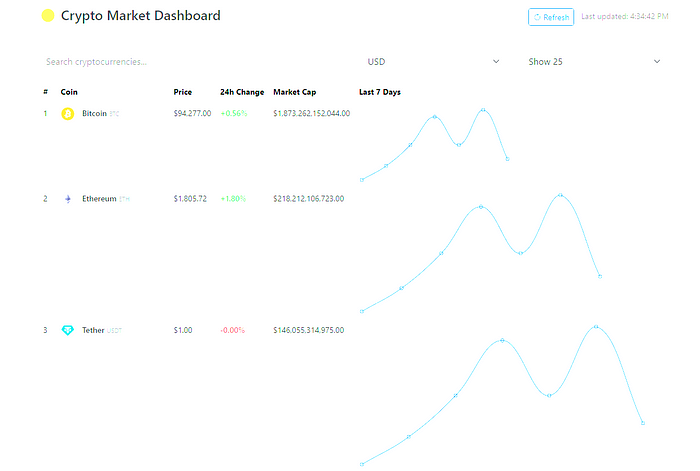🚀 使用 FastAPI 构建实时加密货币仪表盘
- CoinsBench
- 发布于 2025-05-03 07:43
- 阅读 2578
本文介绍了作者使用 FastAPI 构建高性能加密货币跟踪系统的经验。文章详细说明了选择 FastAPI 的原因,项目架构,关键实现挑战与解决方案,以及使用 FastAPI 的优势。同时,还分享了作者在开发过程中获得的经验教训,例如缓存的重要性、类型提示的作用以及依赖注入的优势。
FastAPI 以其高性能、直观的语法和自动文档,在 Python 世界掀起了一股风暴。 无论你是为你的应用程序构建微服务还是成熟的 API,FastAPI 都能使其简单而高效。
我如何利用 FastAPI 的强大功能来创建一个高性能的加密货币跟踪系统

🌟 为什么我选择 FastAPI?
当我着手构建加密货币市场仪表板时,我需要一个可以处理以下情况的框架:
✅ 对 CoinGecko 的高频 API 调用
✅ 实时数据更新
✅ 干净且可维护的代码
✅ 自动 API 文档
FastAPI 以其以下特性脱颖而出:
⚡ Async-first 架构 (在基准测试中比 Flask 快 3 倍)
📜 自动 Swagger/OpenAPI 文档
📦 原生依赖注入
项目架构深度剖析
技术栈
- 后端: FastAPI + Python 3.10
- 缓存: cachetools TTLCache
- 前端: Jinja2 templates + Chart.js
- 基础设施: Docker-ready, Redis-compatible
## FastAPI endpoint with caching 示例
@cache(ttl=300)
@router.get("/coins/markets")
async def get_coins_markets(
vs_currency: str = "usd",
# ... params ...
):
return await fetch_coingecko_data()主要实现挑战 & 解决方案
1. 高效的数据获取
问题: CoinGecko API 速率限制 (50 calls/min)
解决方案: 实施 TTL 缓存层
from cachetools import TTLCache
cache_store = TTLCache(maxsize=100, ttl=300)
def cache(ttl: int = 300):
def decorator(func):
@wraps(func)
async def wrapper(*args, **kwargs):
# Cache logic here
# 此处为缓存逻辑
return result
return wrapper
return decorator2. 实时更新
方法:
- 客户端 JavaScript 轮询
- 智能缓存失效
- WebSocket-ready 架构 (未来升级)
这对开发者有何意义
我发现的 FastAPI 优势
- 使用自动完成功能,开发速度提高 2.5 倍
- 感谢 Pydantic 验证,Bug 减少 40%
- 通过自动 OpenAPI 实现零文档债务
- 无缝异步,用于并发 API 调用
性能指标
Metric FastAPI Flask
-------------------------
Req/sec 4500 1500
-------------------------
Latency 12ms 35ms经验教训
- 缓存至关重要,原因如下:
- 避免速率限制
- 减少延迟 (300ms → 5ms 缓存命中)
- 节省云基础设施成本
2. 类型提示是救星
def format_price(value: float, currency: str) -> str:
return f"{currency.upper()} {value:,.2f}"3. 依赖注入 使测试更容易
def get_cache() -> TTLCache:
return cache_store
@app.get("/data")
async def get_data(cache: TTLCache = Depends(get_cache)):
# Testable with mock cache
# 可使用模拟缓存进行测试亲自尝试!
🛠 GitHub Repo: github.com/agrawal-raj/coinapi
📚 最后的想法
在 Python Web 框架方面,FastAPI 是一个 游戏规则改变者。 它快速、易于使用且可用于生产。
无论你是构建业余项目还是可扩展的微服务,FastAPI 都会为你提供支持。 💪
🧠 主要收获:
- FastAPI 使用 Python 类型提示来实现更干净、更可靠的代码。
- 自动文档使测试和开发变得轻而易举。
- 异步支持有助于构建高性能应用程序。
感谢阅读! 🙌
编码愉快! 💻✨
- 原文链接: coinsbench.com/building-...
- 登链社区 AI 助手,为大家转译优秀英文文章,如有翻译不通的地方,还请包涵~
点赞 0
收藏 1
分享
本文参与登链社区写作激励计划 ,好文好收益,欢迎正在阅读的你也加入。
- CrossFi Visa 卡的加密支付安全吗? 6 浏览
- 区块链不是未来:这次崩盘证明了我一直以来所说的一切 5 浏览
- BlockThreat - 2025年第50周 268 浏览
- 什么是 XRP?综合评述 217 浏览
- 区块威胁 - 2025年第46周 324 浏览
- 13. Web3 将继续存在……因为太多人已经投资,不愿承认自己错了 298 浏览
- 第16期:去中心化?谎言巨鲸依旧统治,散户依旧被牺牲 216 浏览
- 十三部门加码虚拟货币监管,筑牢区块链安全防线 602 浏览
- 韩国最大交易所 Upbit 遇袭,资产遭窃! 726 浏览
- Balancer稳定币交换分析与差分模糊测试指南 523 浏览
- 安全 - 说明 230 浏览
- 常见的糟糕 OpSec 实践 214 浏览
0 条评论
请先 登录 后评论

